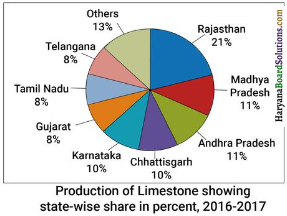Haryana State Board HBSE 10th Class Social Science Solutions Geography Chapter 5 Minerals and Energy Resources Textbook Exercise Questions and Answers.
Haryana Board 10th Class Social Science Solutions Geography Chapter 5 Minerals and Energy Resources
HBSE 10th Class Geography Minerals and Energy Resources Intext Questions and Answers
Dig a Little Deeper (Page No. 48)
Class 10 Geography Chapter 5 Solutions HBSE Question 1.
Find out how many minerals are used to make a light bulb?
Answer:
- Mica
- Tungsten
- Copper
- Aluminium
- Argon (a gas, not a mineral).
HBSE 10th Class Geography Chapter 5 Minerals and Energy Resources Question 2.
Collect “Nutritional Facts” printed on food labels.
Answer:
Food item – Biscuit (Sunfeast 100 gm)
Nutritional facts –
- Energy = 448.5 cal
- Protein = 8.7 gm
- Carbohydrates = 76.2 gm
- Fats = 12.1 gm.
Dig a Little Deeper (Page No. 50)
Minerals and Energy Resources Chapter 5 Geography HBSE 10th Class Question 3.
What is the difference between an open pit mine, a quarry and an underground mine with shafts?
Answer:
Open Pit Mine : Open-pit mining refers to a method of extracting minerals from the earth by their removal from an open pit. These mines are used when deposits of commercially useful minerals or rocks are found near the surface. The layer above the seam is removed and the exposed deposit is extracted using earth-moving machinery.
Quarry : Quarry is usually shallower than open-pit mines. It is generally used for extracting building materials, such as limestone.
Underground Mine with shafts : Underground mine is used when minerals occur deep below the surface or the minerals occur as veins in hard rock. Underground shaft mining is used to extract precious material. Shaft mines have vertical access to the seam via elevators, that carry workers and equipment into the mines. It is the deepest form of underground mining.
![]()
Dig a Little Deeper (Page No. 51)
Question 4.
Superimpose the maps showing distribution of iron ore, manganese, coal and iron and steel industry. Do you see any correlation ? Why?
Answer:
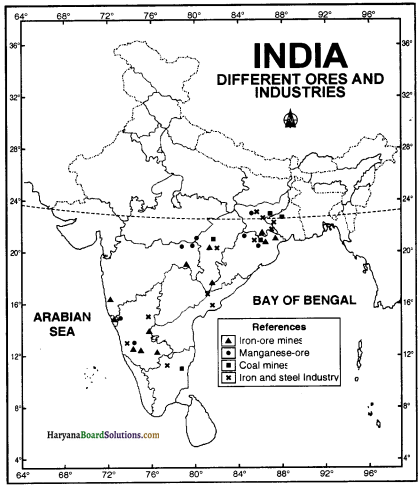
Correlation: Iron-ore, manganese and coal are found very close to each other. Iron and steel industries have also been established in the same region. The reasons behind this correlation are :
- Iron-ore and manganese are the basic raw materials required for iron and steel industry.
- Coal is also required in abundance, to produce energy for melting purposes.
- Raw materials required for iron and steel industry are bulky.
Their transportation will be very costly therefore, industries have been established in the regions which are rich in iron, manganese and coal.
![]()
Dig a Little Deeper (Page No. 53)
Question 5.
Locate the mines of Bauxite on the physical map of India.
Answer:
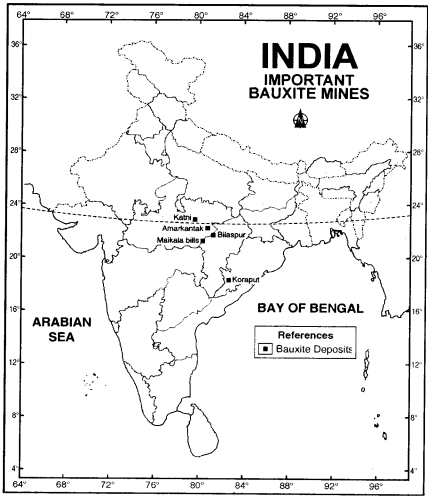
Dig a Little Deeper (Page No. 54)
Question 6.
Study the maps to explain why Chotanagpur is a store house of minerals.
Answer:
Chotanagpur Plateau is spread in Jharkhand and West Bengal states. This plateau is made up of Achian, granite, colarite and basalt rocks. It is formed by igneous and metamorphic rocks, therefore various minerals can be seen in the veins of these rocks. The various minerals obtained from these rocks are coal, copper, mica, bauxite, limestone, iron- ore, krynite, asbestus, uranium, dolomite, manganese and gold etc
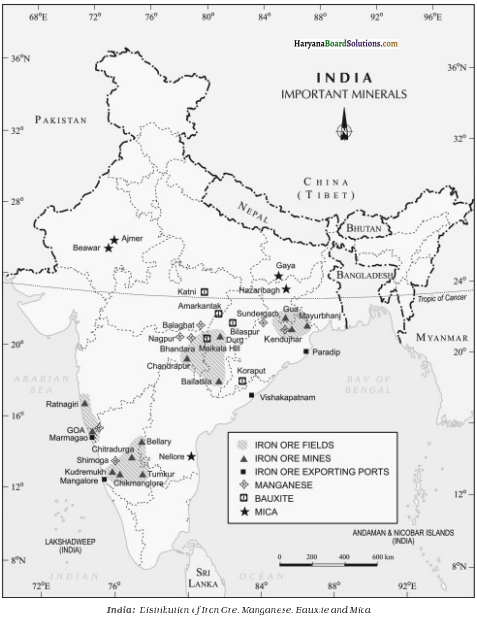
Dig a Little Deeper (Page No. 56)
Question 7.
Make a list of items where substitutes are being used instead of minerals. Where are these substitutes obtained from?
Answer:
| Minerals | Substitutes | Substitutes Obtained from |
| (i) Petroleum | C.N.G. (CompressedNatural Gas) | Beneath the earth |
| (ii) Thermal Power (Obtained from Coal) | Hydel Power | Rainwater & rivers |
| (iii) Electrical appliances made by metals. | Plastic | Chemicals |
| (iv) Chairs made by metals. | Plastic | Chemicals |
Activity (Page No. 58)
Question 8.
Name some river valley projects and write the names of dams built on these rivers.
Answer:
| River Valley Project | Name of river | Name of dams |
| 1. Chambal Valley Project | Chambal | Gandhi Sagar Dam, Rana Pratap Sagar Dam. Jawahar Sagar Dam, Kota Barrrage |
| 2. Bhakra Nangal Project | Satluj | Bhakra-Nangal Dam |
| 3. Damodar Valley Project | Damodar, Barakar | Panchet,Tilaiya, Maithon |
| 4. Hirakund Dam Project | Konnar | and Konar Dams. |
| 5. Tehri Dam Project | Mahanadi | Hirakud Dam |
| 6. Nagaijun Sagar Project | Bhilangana and Bhagirathi | Tehri Dam |
| 7. Kosi Project | Krishna | Nagaijun Sagar Dam |
| 8. Sardar Sarovar Project | Kosi | Kosi Dam |
| 9. Koyna Project | Narmada | Sardar Sarovar Dam |
| 10. Idukki Project | Koyna | Koyna Dam |
(Page No. 60)
Question 9.
Collect information about newly-established Solar Power Plants in India.
Answer:
Newly established Solar Power Plants in India are-
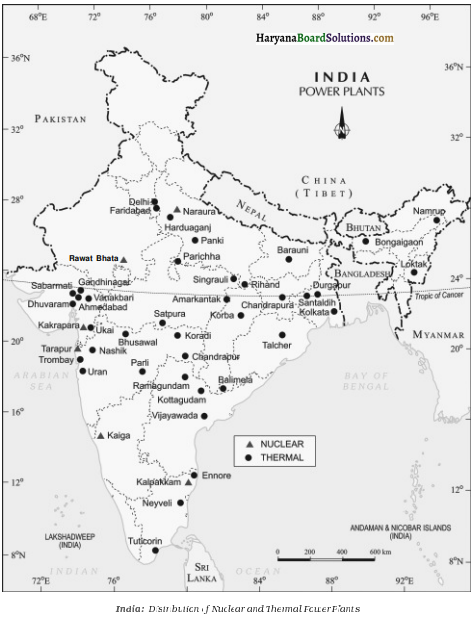
Question 10.
Locate the 6 nuclear power stations and find out the state in which they are located.
Answer:
| Nuclear Power Station | State |
| 1. Naraura | Uttar Pradesh |
| 2. Rawat Bhata | Rajasthan |
| 3. Kakrapara | Gujarat |
| 4. Tarapur | Maharashtra |
| 5. Kaiga | Karnataka |
| 6. Kalpakkam | Tamil Nadu |
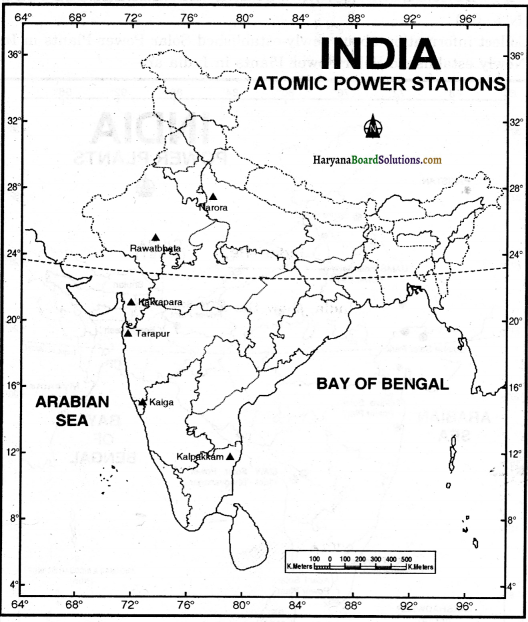
HBSE 10th Class Geography Minerals and Energy Resources Textbook Questions and Answers
1. Multiple Choice Questions :
(i) Which of the following minerals is formed by decomposition of rocks, leaving a residual mass of weathered material?
(a) Coal
(b) Bauxite
(c) Gold
(d) Zinc.
Answer:
(b) Bauxite
(ii) Koderma, in Jharkhand is the leading producer of which of the following minerals?
(a) Bauxite
(b) Mica
(c) Iron ore
(d) Copper
Answer:
(b) Mica
(iii) Minerals are deposited and accumulated in the strata of which of the following rocks :
(a) Sedimentary rocks
(b) Igneous rocks
(c) Metamorphic rocks
(d) None of the these.
Answer:
(a) Sedimentary rocks
(iv) Which of the following minerals is contained in Monazite sand?
(a) Oil
(b) Uranium
(c) Thorium
(d) Coal.
Answer:
(c) Thorium
![]()
2. Answer the following questions in about 30 words :
(i) Distinguish between the following in not more than 30 words :
(a) Ferrous and non-ferrous minerals.
(b) Conventional and non-conventional sources of energy.
Answer:
(a) Ferrous and non-ferrous minerals
Ferrous Minerals:
- Minerals which contain iron-ore are called ferrous minerals.
- Iron-ore, nickel, manganese, tungsten, cobalt are important ferrous minerals.
Non Ferrous Minerals:
- Minerals which do not contain iron-ore are called non-ferrous minerals.
- Copper, zinc, gold, silver, mica are important non-ferrous minerals.
(b) Conventional and non-conventional sources of energy :
conventional Energy Sources:
- These resources have been in use by human since ancient times.
- These are non-renewable sources of energy, e.g., coal and petroleum.
- Over use of these resources causes environmental pollution.
Non-conventional Energy Sources:
- These resources have been in use by human beings for some decades.
- These are renewable sources of energy, e.g., solar energy, wind energy.
- These resources do not cause any type of pollution.
(ii) What is a Mineral?
Answer:
A substance which is found in the earth’s crust, and which generally has a definite chemical composition unlike most rocks is called mineral. According to geologists, mineral is a homogenous, naturally occurring substance, with a definite internal structure.
(iii) How are minerals formed in igneous and metamorphic rocks?
Answer:
Sometimes, minerals in the liquid or molten and gaseous forms are pushed upward due to the internal movement of the earth. These minerals, after passing through the cracks, cavities, faults or joints of the igneous and metamorphic rocks, get cooled, and solidify on the earth’s surface.
![]()
(iv) Why do we need to conserve mineral resources?
Answer:
We need to conserve mineral resources for the following reasons :
- Geological process of mineral formation is very slow and takes millions of years.
- Minerals are non-renewable resources.
- These are of vital need for us, and for developmental activities.
- According to geologists, stocks of minerals are depleting fast.
- Mining of minerals is a costly process.
3. Answer the following questions in about 120 words :
(i) Describe the distribution of coal in India.
Answer:
In India, coal occurs in rock series of two main geological ages:
(a) The Gondwana series
(b) The tertiary series.
(a) The Gondwana coal occurs over 200 million years in age. The Gondwana coal, which are metallurgical coal, are located in Damodar Valley (West Bengal-Jharkhand). Jharia, Raniganj, Bokaro are important coal fields. The Godavari, Mahanadi, Son and Wardha valleys also contain coal deposits.
(b) Tertiary coal occurs only about 55 million years in age. The maj or sources of tertiary coals occur in the north eastern states of Meghalaya, Assam, Arunachal Pradesh and Nagaland. In India, coal is the most abundantly available fossil fuel. It provides a substantial part of the nation’s energy needs. It is used for power generation, to supply energy to the industry as well as for domestic needs. F our types of coals, i.e. lignite, bituminous, anthracite and peat are found.
![]()
(ii) Why do you think that solar energy has a bright future in India?
Answer:
Solar energy has a bright future in India because India is a tropical country. Thus, it has enormous possibilities of tapping solar energy. India has Thar desert which can become the biggest solar power house of India. Solar energy is a renewable source. It does not cause pollution. It is comparatively easy and cheaper to be installed at a local level. Solar plants can be easily established in rural and remote areas.
This will reduce dependence on firewood and dung cakes in rural households. It can be used for cooking, pumping water, refrigerators and street lighting. So, its demand will increase in future. Since India is a developing country, there is every possibility of-increase in consumption of power. Solar energy availability in India is about 20 mw. per sq. km. per annum. Therefore, I think solar energy has a bright future in India.
Knowledge Basket
Fill the names of the correct mineral in the crossword below:
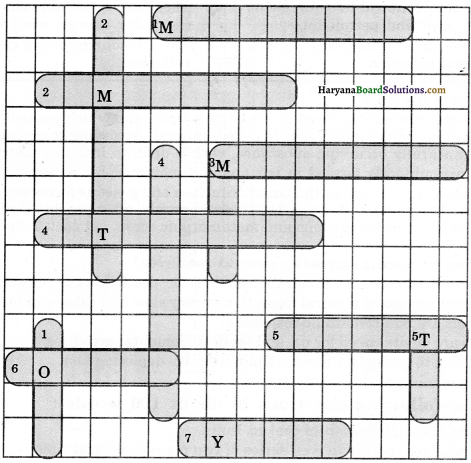
Across
1. A ferrous mineral (9)
2. Raw material for cement industry (9)
3. Finest iron-ore with magnetic properties (9)
4. Highest quality hard coal (10)
5. Aluminium is obtained from this ore (7)
6. Khetri mines are famous for this mineral (6)
7. Formed due to evaporation (6)
Down
1. Found in placer deposit (4)
2. Iron-ore mined in Bailadila (8)
3. Indispensable for electrical industry (4)
4. Geological age of coal found in north-east India (8)
5. Formed in veins and lodes (3)
Answer:
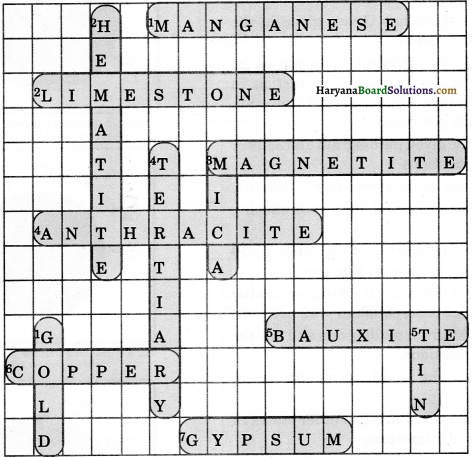
Question 1.
Study the given pie diagram and answer the following questions :
(i) Which is the largest iron-ore producing state of India?
(ii) Name the second largest iron producing state.
(iii) Name any three iron-ore producing states.
Answer:
(i) Odisha
(ii) Chhattisgarh
(iii) (a) Karnataka (b) Jharkhand (c) Goa.
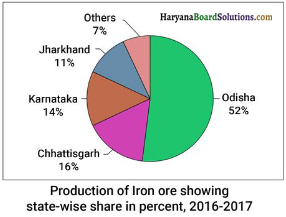
Question 2.
Study the given pie diagram and answer the following questions:
(i) Name the leading manganese producing state of India.
(ii) How much share Madhya Pradesh has in producing manganese?
(iii) What share has Orissa given in the production of manganese?
Answer:
(i) Madhya Pradesh, it accounted for one third of the county’s total production in 2016-17
(ii) Madhya Pradesh = 27 per cent
(iii) Odisha = 25 per cent.
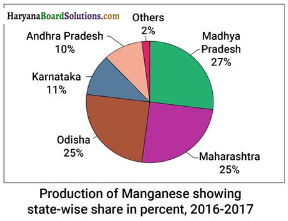
Question 3.
Study the given pie diagram and answer the following questions:
(i) Name the leading producer of Bauxite.
(ii) Name the second largest producing state of Bauxite.
(iii) State the sharing of Jharkhand and Odisha in the production of Bauxite.
Answer:
(i) Odisha
(ii) Gujarat
(iii) Jharkhand = 9 per cent, Odishah = 49 per cent.
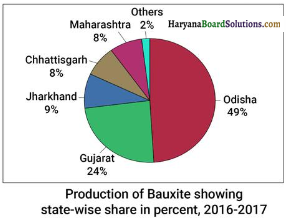
Question 4.
Study the given pie diagram and answer the following questions:
(i) Name the leading producer of Limestone.
(ii) Mention the sharing of other states in the production of Limestone.
(iii) Write any one industrial use of Limestone.
Answer:
(i) Rajasthan = 21%
(ii) Other states = 79%
(iii) Limestone is the basic raw material for the cement industry and essential for smelting iron ore in the blast furnace.
